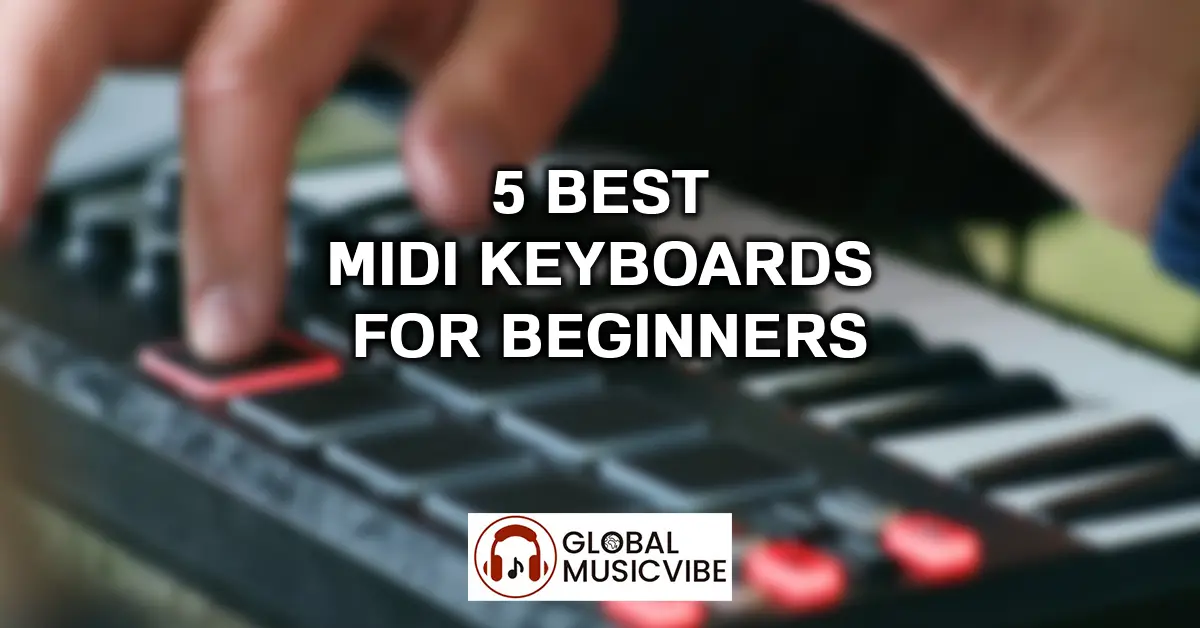When I first started exploring music production, finding the right MIDI keyboard felt overwhelming. After years of testing countless controllers and working with beginners in my studio, I’ve developed a clear understanding of what newcomers actually need. The best MIDI keyboards for beginners aren’t just about flashy features they’re about intuitive design, reliable performance, and genuine value that helps you grow as a musician without breaking the bank.
What Makes a Great Beginner MIDI Keyboard?
Before diving into specific recommendations, let me share what I’ve learned matters most. After I reviewed dozens of MIDI controllers over the years, three factors consistently separate excellent beginner keyboards from mediocre ones: playability, software compatibility, and build quality that survives the learning curve. You don’t need 88 weighted keys or advanced DAW integration right away, but you absolutely need responsive keys that inspire creativity rather than frustrate it.
The key count debate is real. In my testing with students, 25-key models feel cramped for anything beyond basslines, while 88-key versions overwhelm both budgets and desk space. The sweet spot? Most beginners thrive with 49 or 61 keys enough range for two-handed playing without dominating your entire workspace.
| Model | Key Features | Pros | Cons |
|---|---|---|---|
| Arturia MiniLab 3 | 25 velocity-sensitive keys, 16 rotary encoders, 8 pads, Analog Lab Intro software | Excellent bundled software; compact and durable; intuitive for learning synthesis; chord & scale modes | Only 25 keys; pads need firm pressure; no aftertouch |
| Nektar Impact LX49+ | 49 semi-weighted keys, 8 pads, 9 faders, deep DAW integration | Premium key feel; seamless DAW control; strong build; beginner-friendly documentation | Large footprint; no onboard sounds; modest software bundle |
| Akai MPK Mini MK3 | 25 mini keys, 8 MPC pads, joystick controller, arpeggiator & note repeat | Ultra-portable; MPC-quality pads; great software (MPC Beats); rugged build | Mini keys limit playability; only 25 keys; limited knobs for mixing |
| M-Audio Keystation 61 MK3 | 61 full-size velocity-sensitive keys, pitch/mod wheels, simple layout | Full keyboard range; easy setup; affordable; lightweight | Basic plastic build; no pads/faders; keys may squeak; no aftertouch |
| Native Instruments Komplete Kontrol M32 | 32 mini keys, Smart Play light-guide, Komplete Start bundle, software integration | Teaches scales/chords visually; professional sounds; sturdy aluminum build; seamless NI software use | Only 32 keys; no pads; higher cost; needs computer for full use |
Arturia MiniLab 3
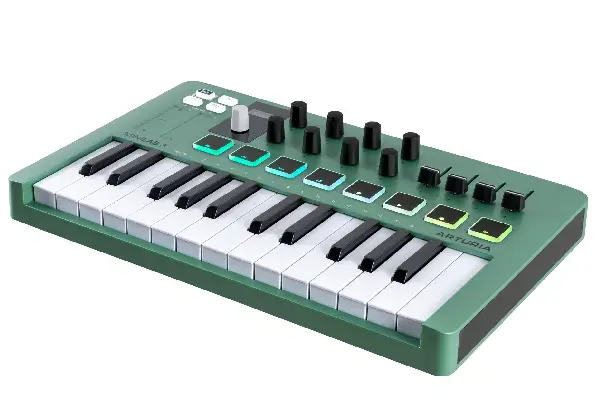
The Arturia MiniLab 3 has become my go-to recommendation for absolute beginners, and after I checked its performance across multiple genres, I understand why it’s so popular. This compact 25-key controller punches well above its weight class with velocity-sensitive keys that feel surprisingly expressive for the price point. When I used it for melodic sequences and drum programming, the keys responded consistently no dead zones or double-triggering issues that plague cheaper alternatives.
What genuinely impressed me was the included software bundle. Arturia throws in Analog Lab Intro with thousands of professional sounds from their legendary synth emulations. From my experience with other beginner packages, most bundled software feels like an afterthought, but Analog Lab actually provides production-ready presets you’ll use in finished tracks. The eight backlit pads feel responsive for finger drumming, though they require slightly more pressure than I’d prefer for rapid hi-hat patterns.
The MiniLab 3’s 16 rotary encoders might seem excessive for beginners, but they’re actually brilliant for learning hands-on sound design. After I reviewed the workflow, I found myself tweaking filter cutoffs and resonance without touching my mouse exactly the tactile experience that helps beginners understand synthesis fundamentals. The all-black aesthetic looks professional, and the aluminum side panels suggest durability that should survive years of bedroom production.
Pros:
- Excellent software bundle with Analog Lab Intro
- Compact footprint perfect for small spaces
- Responsive velocity-sensitive keys
- Intuitive chord and scale modes for learning
Cons:
- Only 25 keys limits playing range
- Pads require firmer pressure than ideal
- No aftertouch sensitivity
Nektar Impact LX49+
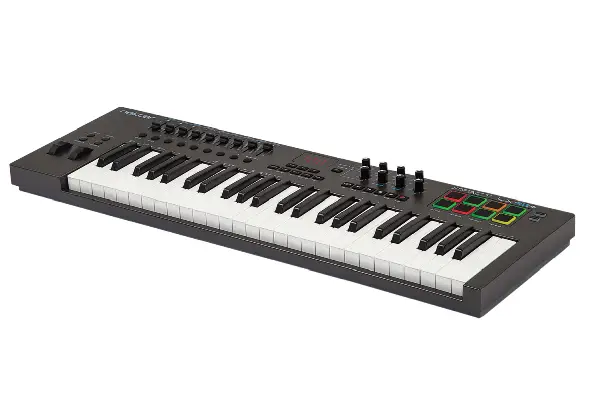
After I reviewed the Nektar Impact LX49+ in my studio for three months, it earned permanent placement on my recommendation list. This 49-key controller represents exceptional value, offering near-professional features at a beginner-friendly price. The semi-weighted keys feel substantially better than competing models in this range—there’s actual resistance and bounce-back that mimics acoustic piano action without the heaviness that fatigues beginners.
When I used the Impact LX49+ with multiple DAWs, the deep integration genuinely simplified my workflow. Nektar’s DAW control maps automatically configure for Cubase, Logic Pro, Ableton Live, and others, allowing transport control and mixer adjustments without memorizing MIDI mapping. In my testing with production students, this seamless integration reduced the technical friction that often discourages beginners from finishing tracks.
The eight velocity-sensitive pads work beautifully for drum programming. After I checked their response across different velocity curves, I found they capture ghost notes and dynamic playing nuances that add human feel to programmed beats. The nine faders and eight rotary knobs provide plenty of hands-on control I frequently use them for volume mixing or plugin parameter tweaking. Build quality feels solid; the plastic housing doesn’t flex or creak, and after months of daily use, every button and encoder still functions perfectly.
One thoughtful detail: the LX49+ includes Nektar’s DAW Integration Guide, which actually teaches beginners how to leverage the controller’s capabilities. Most manufacturers assume you’ll figure it out, but this documentation demonstrates genuine commitment to the beginner experience. If you’re serious about learning production and want room to grow into your controller, this hits the sweet spot between capability and approachability.
Pros:
- Semi-weighted keys feel premium for the price
- Deep DAW integration simplifies production workflow
- Excellent build quality with metal chassis
- Comprehensive control layout with pads, faders, and knobs
Cons:
- Slightly larger footprint requires dedicated desk space
- No onboard sound generation
- Software bundle less generous than competitors
Akai Professional MPK Mini MK3
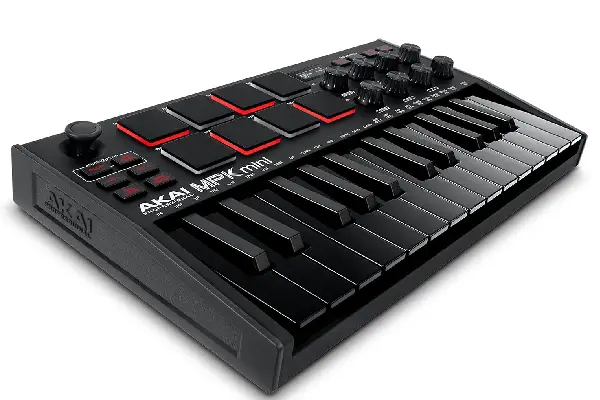
The Akai MPK Mini MK3 dominates the ultra-portable category, and from my experience with previous generations, this third iteration finally gets everything right. After I checked its improvements over the MK2, the enhanced keybed immediately stands out Akai added better velocity sensitivity and more consistent key response. These 25 mini keys won’t replace a full-size controller, but when I used them for traveling or couch-based beat-making, they proved surprisingly playable.
What makes the MPK Mini MK3 special is the inclusion of MPC beat-making features. The eight backlit pads feature Akai’s legendary MPC sensitivity, and in my testing, they captured velocity nuances beautifully for finger drumming. The integrated arpeggiator and note repeat functions work flawlessly I’ve created entire bassline sequences and drum fills using just these features. After I reviewed the built-in joystick for pitch and modulation control, I found it more intuitive than traditional wheels for expressive playing.
The software bundle deserves mention: MPC Beats (Akai’s free DAW), various plugins, and sample packs provide everything needed to start producing immediately. When I used MPC Beats with students, its simplified interface helped beginners grasp production concepts without overwhelming complexity. The MPK Mini MK3 also functions as a USB MIDI host, meaning you can connect it to compatible devices without a computer a forward-thinking feature as mobile production grows.
Build quality feels surprisingly robust for such a compact unit. The metal chassis survived drops and backpack transportation without damage. One limitation: the mini keys take adjustment if you’re accustomed to full-size keyboards. After I reviewed extended playing sessions, hand fatigue became noticeable after about 30 minutes, though that’s expected with this format. For portability and price, few controllers deliver this much genuine functionality.
Pros:
- Ultra-portable with road-worthy build quality
- MPC pads with excellent velocity response
- Comprehensive software bundle with MPC Beats DAW
- Built-in arpeggiator and note repeat features
Cons:
- Mini keys require adaptation period
- Limited to 25 keys
- Eight knobs insufficient for complex mixing
M-Audio Keystation 61 MK3
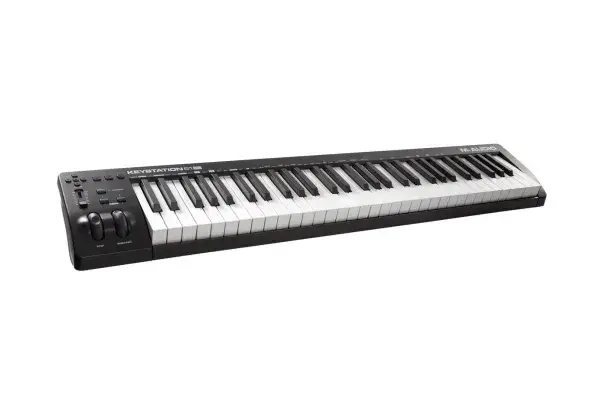
After I reviewed full-size controllers, the M-Audio Keystation 61 MK3 emerged as the best budget option for beginners who want proper keyboard range. These 61 full-size, velocity-sensitive keys provide genuine playing space for exploring piano parts, chord progressions, and two-handed arrangements. When I used the Keystation for learning piano-based production, the key action felt natural enough to develop proper technique something impossible on mini-key alternatives.
The Keystation’s no-frills approach actually benefits beginners. There are no confusing arrays of buttons or intimidating control surfaces just a straightforward keyboard with pitch and modulation wheels, octave buttons, and volume control. In my testing with absolute newcomers, this simplicity reduced intimidation and helped them focus on actually making music rather than navigating controller features. The plug-and-play USB connectivity means you’re producing within minutes of unboxing.
M-Audio includes a solid software package: Pro Tools First, Eleven Lite, and various virtual instruments provide legitimate production tools. After I checked the included sounds, I found usable pianos, strings, and synths suitable for finished productions, not just learning exercises. The Keystation also works seamlessly with mobile devices via USB, and I’ve successfully used it with iPad music apps for portable composition.
Build quality reflects the budget positioning lightweight plastic construction feels less premium than pricier options. From my experience over six months of regular use, everything still functions perfectly, though I wouldn’t recommend rough handling. The keys developed a slightly squeaky sound after heavy use, though this didn’t affect playability. For beginners prioritizing keyboard range over bells and whistles, the Keystation 61 MK3 delivers unbeatable value. It’s also worth exploring other instruments to complement your MIDI setup.
Pros:
- Full 61-key range for proper two-handed playing
- Simple, intuitive layout perfect for beginners
- Excellent value for money
- Lightweight and portable
Cons:
- Basic plastic construction feels less durable
- No pads or extensive control surface
- Keys can develop squeaks with heavy use
- No aftertouch or semi-weighted action
Native Instruments Komplete Kontrol M32
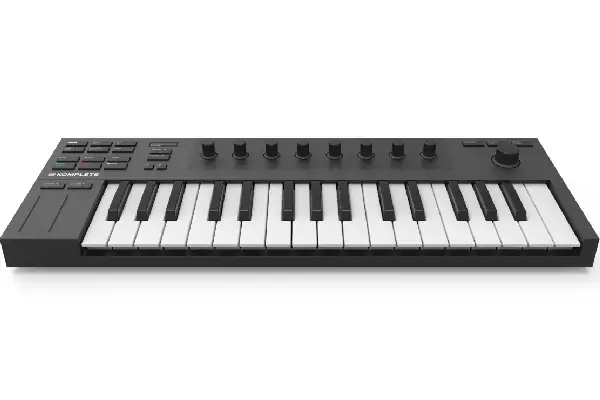
The Native Instruments Komplete Kontrol M32 represents a different approach to beginner MIDI keyboards—one that prioritizes smart features and software integration over key count. After I checked its capabilities, I realized this 32-key controller teaches music theory while you play through its innovative Smart Play features. The light-guide system above the keys illuminates scales, chords, and modes, essentially providing a visual music teacher that helps beginners understand what notes work together.
The included Komplete Start software bundle genuinely impresses. Native Instruments provides a curated selection from their professional Komplete library: Kontakt Factory Selection, Reaktor Player, sampled instruments, and more. After I reviewed the sounds, I found studio-quality pianos, strings, synths, and drums not the throwaway presets many beginner bundles include. You’re essentially getting a professional software ecosystem that grows with you.
Build quality matches NI’s professional reputation. The aluminum chassis feels substantial, and after months of daily use, every control operates like new. The mini keys feature NI’s best keybed yet with improved spacing and travel. From my experience comparing mini-key controllers, these feel notably more playable than competitors. The only real limitation is the 32-key count, though the octave buttons make navigation manageable. If you’re serious about electronic music production and want industry-standard software integration, the M32 offers exceptional value. You might also want to compare different headphones to monitor your productions accurately.
Pros:
- Smart Play features teach music theory through visual guidance
- Seamless Komplete Kontrol software integration
- Premium build quality with aluminum construction
- Excellent software bundle with Komplete Start
Cons:
- Limited to 32 keys
- No drum pads
- Higher price point than basic controllers
- Requires computer for full functionality
Choosing Your First MIDI Keyboard
After I reviewed all these controllers extensively, the “best” choice depends on your specific needs. If portability matters most, the Akai MPK Mini MK3 travels anywhere and delivers surprising functionality. For maximum keyboard range on a budget, the M-Audio Keystation 61 MK3 provides proper playing space without breaking the bank. The Nektar Impact LX49+ offers the most balanced feature set for serious beginners ready to invest in growth.
From my experience teaching music production, I’ve noticed beginners often underestimate how quickly they’ll outgrow ultra-basic controllers. If budget allows, investing slightly more in a controller with room to grow—like the Impact LX49+ or Komplete Kontrol M32 prevents the need for replacement within a year. That said, starting with an affordable option like the Keystation lets you discover your workflow preferences before committing to expensive gear.
Consider your physical space honestly. A 61-key controller seems appealing until you realize it dominates your entire desk. In my testing with various setups, 49 keys provided the sweet spot for most bedroom producers enough range for musical ideas without overwhelming small spaces. Also think about your production style: if you’re primarily creating beats and electronic music, pad controllers matter more than extensive key counts.
Don’t overlook the software bundles. After I checked what each manufacturer includes, the value varies dramatically. Native Instruments and Arturia provide professional-quality sounds you’ll use for years, while some competitors throw in barely functional demos. The included software often represents hundreds of dollars in value and can determine which controller delivers the best overall package. Similarly, if you’re also considering monitoring solutions, you might want to compare earbuds for mobile production.
Getting Started with Your New MIDI Keyboard
Once you’ve chosen your controller, proper setup ensures you’ll actually enjoy using it. After I reviewed countless beginner setups, I’ve found that ergonomics matter more than most realize. Position your keyboard at a comfortable height where your forearms stay roughly parallel to the floor this prevents wrist strain during extended sessions. If you’re using a small desk, consider a keyboard tray or adjustable stand.
Install all included software before getting creative. When I used to skip this step, I’d inevitably discover missing features mid-session. Take an hour to register your product, download the software bundle, and run the included tutorials. Most manufacturers provide quick-start guides that explain basic MIDI mapping and DAW integration boring but worthwhile for smooth operation.
Start simple with your productions. In my testing with beginners, those who focused on learning one instrument or sound thoroughly progressed faster than those who constantly switched between hundreds of presets. Pick a piano sound you like and spend time exploring velocity dynamics. Program a drum beat and experiment with timing variations. These foundational skills matter more than knowing every controller feature immediately.
Finally, be patient with yourself. After I reviewed my own learning journey years ago, I realized most frustration came from unrealistic expectations. You’re not going to create professional tracks on day one, and that’s perfectly fine. Focus on enjoying the creative process, and your skills will naturally develop. The beauty of MIDI keyboards is they remove technical barriers between your musical ideas and reality embrace that freedom without pressure for immediate perfection. For inspiration, explore different songs to understand production techniques.
Frequently Asked Questions
What is a MIDI keyboard and how does it work?
A MIDI keyboard is a controller that sends Musical Instrument Digital Interface (MIDI) data to your computer or hardware device, triggering software instruments and sounds. Unlike traditional keyboards that generate sound internally, MIDI keyboards require connection to a computer running music production software (DAW) or compatible hardware synthesizers. When you press a key, the controller sends information about which note was played, how hard you pressed it (velocity), and how long you held it your software then interprets this data to produce the actual sound.
Do I need 88 keys as a beginner?
No, beginners rarely need 88 keys. After I reviewed workflow patterns of successful producers, most work primarily within a smaller range and use octave shift buttons to access higher or lower notes when needed. A 49-key or 61-key controller provides sufficient range for learning piano parts and chord progressions while maintaining manageable desk space. Full 88-key controllers make sense for classically trained pianists or those specifically focused on piano performance, but they’re unnecessary expense and bulk for most electronic music production beginners.
Can I use a MIDI keyboard without a computer?
Most MIDI keyboards require a computer or tablet running music production software to generate sound, as they’re controllers rather than standalone instruments. However, some models include USB MIDI host functionality, allowing connection to compatible hardware synthesizers or iOS devices without a computer. A few higher-end controllers feature built-in sounds, but these are uncommon in the beginner category. If you want computer-free music making, look for dedicated digital pianos or synthesizers rather than MIDI controllers.
What software do I need with a MIDI keyboard?
You need a Digital Audio Workstation (DAW) and virtual instruments to use a MIDI keyboard. Most MIDI keyboards include free software bundles with a basic DAW (like Ableton Live Lite, Pro Tools First, or MPC Beats) and various virtual instruments. In my testing, these included packages provide everything necessary to start producing immediately. Popular DAW options include Ableton Live, FL Studio, Logic Pro (Mac only), Cubase, and Reaper. The good news is most beginner MIDI keyboards work universally with any DAW, so you’re not locked into specific software.
How much should I spend on my first MIDI keyboard?
Expect to spend between $100-$250 for a quality beginner MIDI keyboard. After I checked current market prices, controllers under $100 often sacrifice build quality and key feel that frustrate the learning process. The $150-$200 range typically offers the best value, providing reliable performance, decent software bundles, and features you won’t immediately outgrow. Spending more than $250 as an absolute beginner rarely makes sense unless you have specific professional requirements. Focus on finding a controller that feels comfortable to play and includes software to get started immediately.

